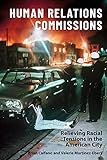Human Relations Commissions : Relieving Racial Tensions in the American City / Brian Calfano, Valerie Martinez-Ebers.
Material type: TextPublisher: New York, NY : Columbia University Press, [2020]Copyright date: ©2019Description: 1 online resource : 15 b&w figuresContent type:
TextPublisher: New York, NY : Columbia University Press, [2020]Copyright date: ©2019Description: 1 online resource : 15 b&w figuresContent type: - 9780231549196
- 306.0973 23
- HN43
- online - DeGruyter
| Item type | Current library | Call number | URL | Status | Notes | Barcode | |
|---|---|---|---|---|---|---|---|
 eBook
eBook
|
Biblioteca "Angelicum" Pont. Univ. S.Tommaso d'Aquino Nuvola online | online - DeGruyter (Browse shelf(Opens below)) | Online access | Not for loan (Accesso limitato) | Accesso per gli utenti autorizzati / Access for authorized users | (dgr)9780231549196 |
Frontmatter -- CONTENTS -- Acknowledgments -- INTRODUCTION: TOO BIG A TASK? -- 1. HUMAN RELATIONS COMMISSIONS: CREATIVITY IN CONSTRAINT -- 2. THE HISTORY OF INTERGROUP RELATIONS IN AMERICA -- 3. ORIGINS AND DEVELOPMENT OF ORGANIZED HUMAN RELATIONS EFFORTS -- 4. THE HUMANS WHO MUST RELATE -- 5. EXPERIMENTING WITH THE DYNAMICS OF INTERGROUP IDENTITY -- 6. REPORTING AND RESPONDING TO COMMUNITY -- 7. IMAGINING HUMAN RELATIONS FOR THE FUTURE -- Appendix -- Notes -- Bibliography -- Index
restricted access online access with authorization star
http://purl.org/coar/access_right/c_16ec
During the 1950s, amid increased attention to the problems facing cities—such as racial disparities in housing, education, and economic conditions; tense community-police relations; and underrepresentation of minority groups—local governments developed an interest in “human relations.” In the wake of the shocking 1965 Watts uprising, a new authority was created: the Los Angeles City Human Relations Commission. Today, such commissions exist all over the United States, charged with addressing such tasks as fighting racial discrimination and improving fair housing access.Brian Calfano and Valerie Martinez-Ebers examine the history and current efforts of human relations commissions in promoting positive intergroup outcomes and enforcing antidiscrimination laws. Drawing on a wide range of theories and methods from political science, social psychology, and public administration, they assess policy approaches, successes, and failures in four cities. The book sheds light on the advantages and disadvantages of different commission types and considers the stresses and expectations placed on commission staff in carrying out difficult agendas in highly charged political contexts. Calfano and Martinez-Ebers suggest that the path to full inclusion is fraught with complications but that human rights commissions provide guidance as to how disparate groups can be brought together to forge a common purpose. The first book to examine these widely occurring yet understudied political bodies, Human Relations Commissions is relevant to a range of urban policy issues of interest to both academics and practitioners.
Mode of access: Internet via World Wide Web.
In English.
Description based on online resource; title from PDF title page (publisher's Web site, viewed 02. Mrz 2022)


